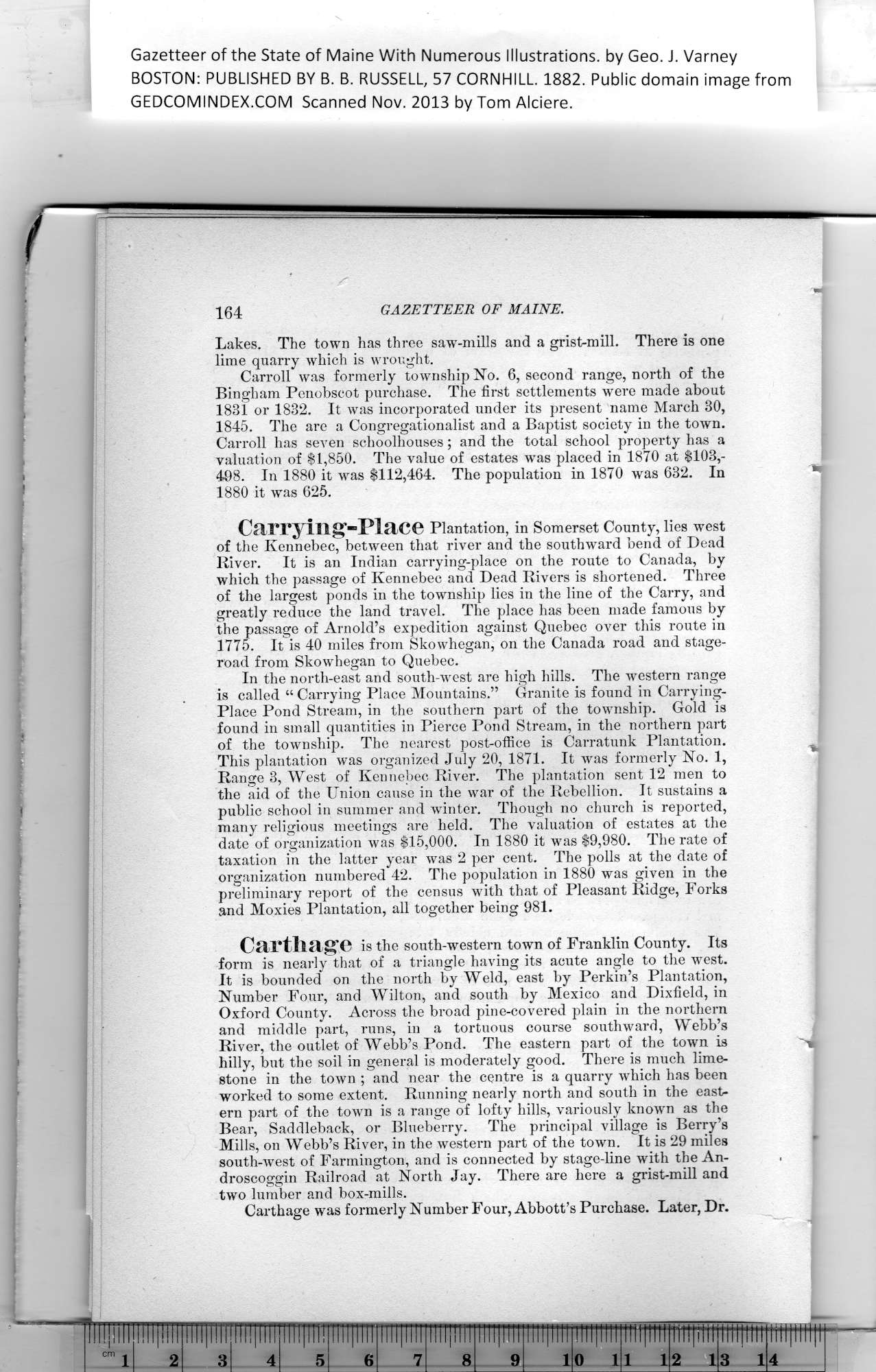|
Gazetteer of the State of Maine With Numerous Illustrations, by Geo. J. Varney
BOSTON: PUBLISHED BY B. B. RUSSELL, 57 CORNHILL. 1882. Public domain image from
164 GAZETTEER OF MAINE.
Lakes. The town has three saw-mills and a grist-mill. There is one
lime quarry which is wrought.
Carroll was formerly township No. 6, second range, north of the
Bingham Penobscot purchase. The first settlements were made about
1831 or 1832. It was incorporated under its present name March 30,
1845. The are a Congregationalist and a Baptist society in the town.
Carroll has seven schoolhouses; and the total school property has a
valuation of $1,850. The value of estates wTas placed in 1870 at $103,-
498. In 1880 it was $112,464. The population in 1870 was 632. In
1880 it was 625.
Carrying-Place Plantation, in Somerset County, lies west
of the Kennebec, between that river and the southward bend of Dead
River. It is an Indian carrying-place on the route to Canada, by
which the passage of Kennebec and Dead Rivers is shortened. Three
of the largest ponds in the township lies in the line of the Carry, and
greatly reduce the land travel. The place has been made famous by
the passage of Arnold’s expedition against Quebec over this route in
1775. It is 40 miles from Skowhegan, on the Canada road and stage-
road from Skowhegan to Quebec.
In the north-east and south-west are high hills. The western range
is called “ Carrying Place Mountains.” Granite is found in Carrying-
Place Pond Stream, in the southern part of the township. Gold is
found in small quantities in Pierce Pond Stream, in the northern part
of the township. The nearest post-office is Carratunk Plantation.
This plantation was organized July 20, 1871. It was formerly No. 1,
Range 3, West of Kennebec River. The plantation sent 12 men to
the aid of the Union cause in the war of the Rebellion. It sustains a
public school in summer and winter. Though no church is reported,
many religious meetings are held. The valuation of estates at the
date of organization was $15,000. In 1880 it was $9,980. The rate of
taxation in the latter year was 2 per cent. The polls at the date of
organization numbered 42. The population in 1880 was given in the
preliminary report of the census with that of Pleasant Ridge, Forks
and Moxies Plantation, all together being 981.
Carthage is the south-western town of Franklin County. Its
form is nearly that of a triangle having its acute angle to the west.
It is bounded on the north by Weld, east hy Perkin’s Plantation,
Number Four, and Wilton, and south by Mexico and Dixfield, in
Oxford County. Across the broad pine-covered plain in the northern
and middle part, runs, in a tortuous course southward, Webb’s
River, the outlet of Webb’s Pond. The eastern part of the town is
hilly, but the soil in general is moderately good. There is much lime-
stone in the town ; and near the centre is a quarry which has been
worked to some extent. Running nearly north and south in the east-
ern part of the town is a range of lofty hills, variously known as the
Bear, Saddleback, or Blueberry. The principal village is Berry’s
Mills, on Webb’s River, in the western part of the town. It is 29 miles
south-west of Farmington, and is connected by stage-line with the An-
droscoggin Railroad at North Jay. There are here a grist-mill and
two lumber and box-mills.
Carthage was formerly Number Four, Abbott’s Purchase. Later, Dr.
PREVIOUS PAGE ... NEXT PAGE
This page was written in HTML using a program written in Python 3.2
|
